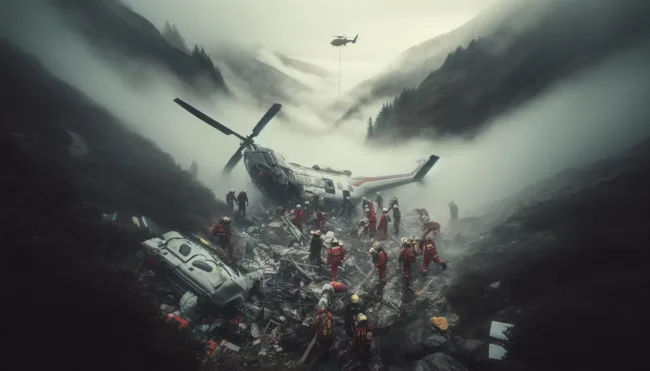Tragic helicopter crash in Iran: President Ebrahim Raisi presumed deceased, no survivors found
In a grave development reported on May 20, 2024, Iranian state media announced that there are no signs of life at the crash site of the helicopter transporting Iranian President Ebrahim Raisi. The crash, which has gripped national and international attention, occurred under challenging conditions in mountainous terrain, according to sources.
Initial Discovery and Response Efforts
The helicopter was located by a Turkish drone, the Bayraktar Akinci, which detected a heat source, aiding rescue teams in pinpointing the site. Despite this technological assistance, thick fog has severely hampered rescue efforts. The Red Crescent’s chief in Iran‘s East Azerbaijan province, Pirhossein Koolivand, confirmed the helicopter’s location and described the ongoing situation as “not good.”
International Aid and Continued Search
In response to the tragic incident, Russia has dispatched a specialized team of 47 rescuers, equipped with all-terrain vehicles and a BO-105 helicopter, to assist in the search and recovery operations. This international collaboration underscores the severity of the crash and the challenging conditions under which the teams are operating.

Helicopter carrying Iranian President Raisi crashes with no survivors detected. Rescue efforts continue under challenging conditions.
Details of the Incident and High-Profile Passengers
The helicopter, also carrying Iranian Foreign Minister Hossein Amir-Abdollahian, East Azerbaijan Province Governor Malek Rahmati, and Ayatollah Mohammad Ali Ale-Hashem, crashed while returning from the inauguration of a dam project near the Iranian-Azerbaijani border. Reports suggest that President Raisi initially chose to drive due to the adverse weather conditions but later boarded the helicopter, which subsequently encountered a “hard landing.”
Expert Analysis and Broader Implications
This incident raises significant concerns about the safety protocols and decision-making processes involved in the transport of high-ranking officials in challenging environments. The involvement of high-profile figures and the tragic outcome may prompt a reevaluation of transportation safety measures, especially in adverse weather conditions.
Ongoing Operations and Next Steps
As operations continue, the focus remains on recovering any survivors and investigating the cause of the crash. The efforts are being closely monitored, with significant resources being deployed to ensure that all possible assistance is provided in these critical moments.
Discover more from Business-News-Today.com
Subscribe to get the latest posts sent to your email.

